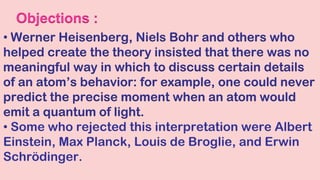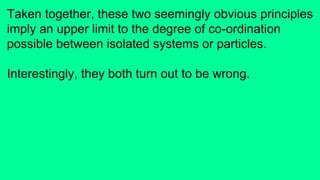EPR paradox
- 1. EPR Paradox Presented By; D Surat M.Sc. Physics Dayalbagh Educational Institute
- 4. OUTLINE Introduction Copenhagen Interpretation Quantum Entanglement Schrodinger cat paradox EPR Paradox Albert Einstein (1879-1955)
- 5. Introduction • By the 1920s, it had become clear to most physicists that classical mechanics could not fully describe the world of atoms, especially the notion of “quanta” first proposed by Planck and further developed by Albert Einstein to explain the photoelectric effect. Physics had to be rebuilt, leading to the emergence of quantum theory.
- 6. Called Copenhagen interpretation of quantum mechanics • Thus, Quantum Mechanics which was born in the 1900s, marked a revolution in Physics. • Werner Heisenberg, Niels Bohr and others helped to create the theory, called Copenhagen interpretation of quantum mechanics . • This is the most genereal interpretation of quantum mechanics.
- 7. The Copenhagen Interpretation The Copenhagen Interpretation is an interpretation of quantum mechanics. It arose out of discussions between Bohr and Heisenberg in 1927 and was strongly supported by Max Born and Wolfgang Pauli.
- 8. The Copenhagen Interpretation • A system is completely described by a wave function Y, which represents an observer's knowledge of the system. (Heisenberg). • The description of nature is probabilistic. The probability of an event is the mag squared of the wave function related to it. (Max Born). • Heisenberg's Uncertainty Principle says it’s impossible to know the values of all of the properties of the system at the same time; properties not known with precision are described by probabilities.
- 9. • Complementarily Principle: matter exhibits a wave- particle duality. An experiment can show the particle-like properties of matter, or wave-like properties, but not both at the same time. (Bohr). • Measuring devices are essentially classical devices, and they measure classical properties such as position and momentum. • The correspondence principle of Bohr and Heisenberg: the quantum mechanical description of large systems should closely approximate the classical description.
- 10. Objections : • Werner Heisenberg, Niels Bohr and others who helped create the theory insisted that there was no meaningful way in which to discuss certain details of an atom’s behavior: for example, one could never predict the precise moment when an atom would emit a quantum of light. • Some who rejected this interpretation were Albert Einstein, Max Planck, Louis de Broglie, and Erwin Schrödinger.
- 11. • Einstein said to Born, •He wasn’t alone in his discomfort: Erwin Schrödinger, inventor of the wave function, once declared of quantum mechanics, “I, at any rate, am convinced that God does not play dice (with the universe).” “I don’t like it, and I’m sorry I ever had anything to do with it.”
- 12. Challenging the completeness of Q.M., in 1935, Einstein together with Rosen and Podolsky published their famous article “Can Quantum Mechanical Description be considered complete?”. Here, they introduced the EPR experiment which demonstrated the deficiencies of Q.M.
- 13. Schrödinger’s Cat To reveal what he considered its absurdity, Schrodinger proposed (but fortunately never implemented!) putting a cat in a sound-proof box and killing it with a ½ probability. Before we open the box, is the cat alive or dead? Even though the cat may feel otherwise, quantum mechanics says the cat is both! It’s in a superposition of “alive” and “dead.”
- 14. Making a measurement on the system (peaking into the box) collapses the cat’s state to either “alive” or “dead.” 1 1 2 2 alive dead
- 15. Quantum Entanglement Quantum entanglement is a physical phenomenon that occurs when pairs or groups of particles are generated or interact in ways such that the quantum state of each particle cannot be described independently of the others, even when the particles are separated by a large distance – instead, a quantum state must be described for the system as a whole.
- 16. • The basic idea of quantum entanglement is that two particles can be intimately linked to each other even if separated by billions of light-years of space; a change induced in one will affect the other. • Measurements of physical properties such as position, momentum, spin, and polarization, performed on entangled particles are found to be appropriately correlated.
- 17. • For example, if a pair of particles are generated in such a way that their total spin is known to be zero, and one particle is found to have clockwise spin on a certain axis, the spin of the other particle, measured on the same axis, will be found to be counter clockwise, as to be expected due to their entanglement. • this behaviour gives rise to paradoxical effects: any measurement of a property of a particle can be seen as acting on that particle and will change the original quantum property by some unknown amount; and in the case of entangled particles, such a measurement will be on the entangled system as a whole.
- 18. • thus appears that one particle of an entangled pair "knows" what measurement has been performed on the other, and with what outcome, even though there is no known means for such information to be communicated between the particles, which at the time of measurement may be separated by arbitrarily large distances.
- 19. Definition of Quantum Entanglement: measurements on spatially separated quantum systems can instantaneously influence one another.
- 20. Planks time: It is the time required for light to travel, in a vacuum, a distance of 1 Planck length, approximately 5.39 × 10-44 s. There are two entangled state A with wave function Y1 and Y2 and sate B with wave function X1 and X2. then, Superposed state: Y1X1+Y1X2+Y2X1+Y2X2 Entangled state: (Y1+Y2)(X1+X2)
- 21. The EPR Paradox
- 22. • The EPR Paradox (or the Einstein-Podolsky-Rosen Paradox) is a thought experiment intended to demonstrate an inherent paradox in the early formulations of quantum theory. • It is among the best-known examples of quantum entanglement. • The paradox involves two particles which are entangled with each other according to quantum mechanics.
- 23. • It seems that our consciousness plays a role in quantum mechanics. • Einstein became uneasy about such implications and, in later years, organized a rearguard action against quantum mechanics. His question, “Do you really think the moon isn't there if you aren't looking at it?” highlights the depths of his distaste for the role of the consciousness. • His strongest counter-argument was a paradoxical implication of quantum mechanics now known as the Einstein-Podolsky-Rosen (EPR) Paradox.
- 24. The Einstein-Podolsky-Rosen Paper • Einstein believed that, while quantum mechanics could be used to make highly accurate statistical predictions about experiments, it’s an incomplete theory of physical reality. • In the May 15, 1935 , Einstein, working with physicists Boris Podolsky and Nathan Rosen, published the paper, “Can Quantum-Mechanical Description of Physical Reality Be Considered Complete?”
- 25. • In this paper, they devised a clever thought experiment that “beat” the Uncertainty Principle. So they concluded that there must be more going on than quantum mechanics knew about, concluding: The quantum-mechanical description of reality given by the wave function is not complete, that is, there must be Hidden Variables that we don’t know about and hence don’t measure that cause the uncertainty.
- 26. EPR: Entangled States • Imagine a pair of particles whose quantum spins are known to be opposite. We can actually know that the total spin S of the two- particle system is zero if it’s in an S = 0 or “singlet” state. So one is spin-up, and the other is spin-down, but we don’t know which is which. Two particles emerging from initial system with opposite spins Initial two- particle system with zero spin
- 27. • Now separate them and measure the spin of one particle. Because they were paired, they have a combined entangled wave function: 1 1 2 2A B A B
- 28. • But we’re free to choose which component of the spin we’d like to measure. Let’s now pick a perpendicular direction. We can write the same statement about that direction also: 1 1 2 2A B A B Two particles emerging from initial system Initial two- particle system
- 29. • Of course, Quantum Mechanics says we cannot make precise measurements of both components; making one measurement perturbs the other. • In any case, making a measurement of either component of one particle’s spin determines the other. When the measurement is made, the wave function collapses: 1 2 A B 1 2 A B or 1 2 A B 1 2 A B
- 30. The EPR Paradox Now do something really interesting: Measure the vertical spin component of particle A and the horizontal spin component of particle B. Because the particle A measurement determines both particles’ vertical spin components, and the particle B measurement determines both particles’ horizontal spin components, haven’t we determined two components of each particle’s spin? And beaten the Quantum Mechanics?
- 31. This would be an argument for the existence of Hidden Variables— additional quantities that exist and affect systems, but we just don’t know about yet and so can’t control them. If this works, then Quantum Mechanics is incomplete, that is, it’s actually possible to make precise measurements if we’re clever, and there’s more going on than is in Quantum Mechanics.
- 32. Alas, Einstein’s trick doesn’t work! Measuring the vertical-spin component of particle A collapses both particles’ vertical-spin-component states, as predicted. But, in the process, it randomizes both particles’ horizontal-spin components! Measuring A’s vertical spin is just like measuring B’s also! Even though we never touched particle B! Quantum Mechanics wins! Quantum Mechanics 1. Einstein 0.
- 33. But now you might wonder: Information can’t travel faster than the speed of light. Suppose we let the particles travel many meters (i.e., many nanoseconds for light) apart, and we make the measurements only picoseconds apart in time, so there isn’t time for the information from the measurement on particle A to reach particle B in time to mess up its measurement. That should save Einstein’s idea.
- 34. But it doesn’t! This information appears to travel infinitely fast. So this appears to invalidate Einstein’s beloved Special Relativity! Quantum Mechanics wins again! Quantum Mechanics 2. Einstein 0.
- 35. Implicit assumptions of EPR The principle of reality: individual particles possess definite properties even when they’re not being observed. The locality principle: information from a measurement in one of two isolated systems cannot produce real change in the other, especially superluminally (faster than c).
- 36. Taken together, these two seemingly obvious principles imply an upper limit to the degree of co-ordination possible between isolated systems or particles. Interestingly, they both turn out to be wrong.
- 37. John Bell showed in a 1964 paper entitled "On the Einstein Podolsky Rosen paradox,” that local realism leads to a series of requirements—known as Bell’s inequalities. John Bell (1928-1990)
- 38. Alain Aspect has performed numerous beautiful experiments, proving conclusively that our universe violates Bell’s Inequalities big time. And quantum mechanics explains the effects quite nicely.
- 39. Applications Entanglement has many applications in quantum information theory. Among the best-known applications of entanglement are superdense coding and quantum teleportation. Most researchers believe that entanglement is necessary to realize quantum computing. Entanglement is used in some protocols of quantum cryptography.
- 40. THANK YOU …







































